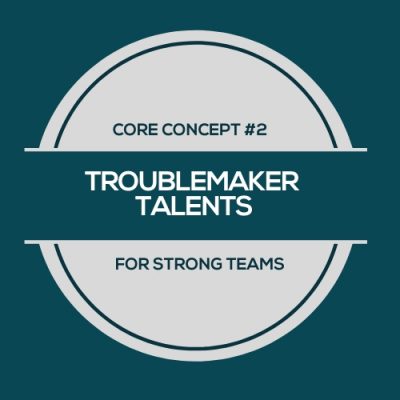Troublemaker Talents – When They’re Overused Or Misapplied
Podcast: Play in new window
Subscribe: Spotify | iHeartRadio | Email | TuneIn | More

What are Troublemaker Talents?
Troublemaker talents are natural talents that have the potential to make you great yet may be causing pain or trouble to you, or to others within the team, due to misapplication, talent overuse, or squashing down of talent.
Note that you may be squashing down a talent or not developing it because you don’t see the necessity. But when it does peek out inevitably, it doesn’t come out looking good.
When talking about strengths, curiosity about the other side -- the so-called “shadow side” or “blind spots” -- tends to surface. And that’s exactly why our next core concept is worth discussing.
Explore your potential troublemaker talents for these takeaways:
1. Workplace scenarios where troublemaker talents can show up
2. How these scenarios may affect teams and team projects
3. What you can do as a team in order to address the possible impact on timelines and results caused by the misapplication, overuse, or squashing down of talent
Are These Troublemaker Talent Scenarios Familiar?
Scenario 1: Love For Learning
Let’s say a member of your team leads through Learner and Input. Coming out of such strength is her love for learning, such as data gathering. As she’s bent on really getting to know the stakeholders and the end-users before beginning a project, she spends a lot of time on the front end of the projects collecting stakeholder specifications and end-user preferences. She really digs into these items thoroughly.
What Makes Them Troublemaker Talents When She Overuses Them?
This is showing up as a troublemaker talent for her because during the process of thorough and in-depth learning, you could see her as being too slow-paced or a “deadline-misser.” This is rooted in the following:
1) Her non-communication of how her workflow looks (70% of the time on front end then super fast during the later phases)
2) Her lack of awareness that would make someone else nervous
What Can You Do As A Team To Deal With Troublemaker Talents?
As you are following a more sensible timeline, and it’s clear that the troublemaker talent is going to make her miss the deadline, you have no choice but to step in. In this scenario, she’ll keep getting her projects pulled as she’s getting them started because you think she’s not going to complete them on time.
Scenario 2: Digging In Or Intruding?
For this same person who loves gathering information, it also comes out as a talent overuse when she spends most of a meeting with a colleague, asking too many questions -- to the point that she causes skepticism and guardedness on her colleague.
What Makes It A Troublemaker Talent When She Asks A Lot Of Questions?
While the main point of the meeting is to explore and learn as much as she can, “too much curiosity kills a cat” as they say, and may spell trouble by way of perceived intrusion.
- “Why the 20 questions?”
- “Why are you digging into my business?”
- “What’s the deal here?”
In the end, when the colleague senses that she’s prying into their business, she might not obtain the information she was driving for.
What Can You Do As A Team To Collaborate Past The Troublemaker Talent?
- Self-awareness - It’s important that this teammate be made aware of where she is not being well-received by others, and where her misapplied talent seems to be getting in the way of her desired results. The ability to reflect on this starts the active process of addressing the “trouble” or pain.
Alternate Example - Maximizer
Maximizers also want to think about things longer and improve on them through constant rework. However, they tend to get stuck on reworking everything they touch. Naturally they go for the highest quality output, which requires that everything must be thought through. In effect, it keeps them from getting ahead along the timeline.
Once and awhile, Maximizers have to be okay with B+ work (which is often A+ work to other people). Of course, this doesn't apply to high-stakes situations and projects. But in everyday life, the constant iteration can go into overuse mode and cause trouble.
The Yin-Yang Complex
Another concept to watch out for in troublemaker talents is the "yin-yang complex" where within a team, we often find talents that look the opposite of someone else's.
Consider the previous example of the leader through Learner and Input. As her boss, you happen to lead through Activator. That means you want to get things moving, and in contrast to her Learner-Input themes, you are really fast on the front end of projects.
Now due to self-awareness or team-awareness about each other’s talent themes, you will know in advance how to handle and address potential trouble. Action steps may look like:
- Ask the Learner-Input team member to communicate and align with you early in the project...
- explanation where there may be gaps
- assurances of how she will strategize to meet the deadline
- Think about the types of projects you should (or should not) assign to her, depending on where her thoroughness may be best utilized.
Your Team Challenge: Identify Troublemaker Talents And Develop Them
This challenge may take a little thinking through. Attack one at a time.
- Think of someone right now that you know, or someone that you've worked with in the past whom you think you’ve often butted heads or clashed with because you were always coming from totally opposite directions. These people are a great case study for your troublemaker talents.
- Assume both their positive intent and your positive intent. See how you're each trying to achieve results for which you may have a very different approach.
- Develop a troublemaker talent into a value-adding talent.
Example Of Turning Around A Troublemaker Talent
Suppose you're a visionary, and while you're passionately presenting about the vision of a project, you feel that your team or a team member is dragging it down into something that's irrelevant. It can be quite maddening.
If you recognize the troublemaker talents in your team, you can avoid the frustrations of being derailed in your vision presentation by talking to that person in advance. Example:
“Hey, I'm going to give you the high level in the meeting, and then let's book an hour after because I know you're gonna have a lot of detailed questions."
So rather than merely point out to them what’s wrong that needs fixing, it’s far more constructive to focus on the team member’s potential. This will inspire them to further develop their strength and to express confidence that they can be among your top talents in the world.
As you both commit support towards this person’s development, imagine the fulfillment for you both if they transform from a “troublemaker” to a superstar!
Bottom line: It's so much more inspirational to craft and develop something that is already strong in you or others than to feel like you need to squash something and stamp it out.
Ready For The Next S.T.R.E.N.G.T.H.S. Core Concept?
The 9 Concepts:
- S: Skills, Experiences, and Talents
- T: Troublemaker Talents
- R: Regulate by Situation
- E: Easy Buttons
- N: Not an Excuse
- G: Gimme That Escalation
- T: Takes Time and Intention
- H: Honored and Insulted
- S: Starved and Fed
Carmie is a professional writer and editor at Lead Through Strengths. Having spent 8 happy years with a nonprofit child organization as a storyteller and sponsorship relations team manager, she continues collaborating with others across the globe for the joy of human development and connection. Her days are powered by coffee, curiosities, cameras (film and digital), music, notebooks, and a cat. Where books are home, she’s home. She calls her Top 5 StrengthsFinder Talents “CLIPS” (Connectedness, Learner, Intellection, Positivity, and Strategic)–you know, those tiny objects that hold connected things together. She’d like to think she’s one.

